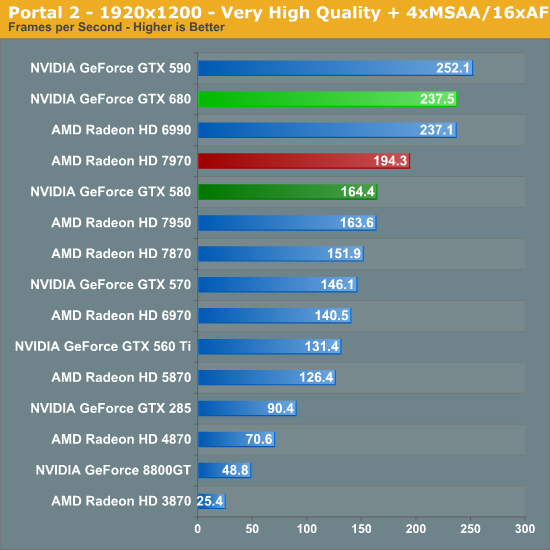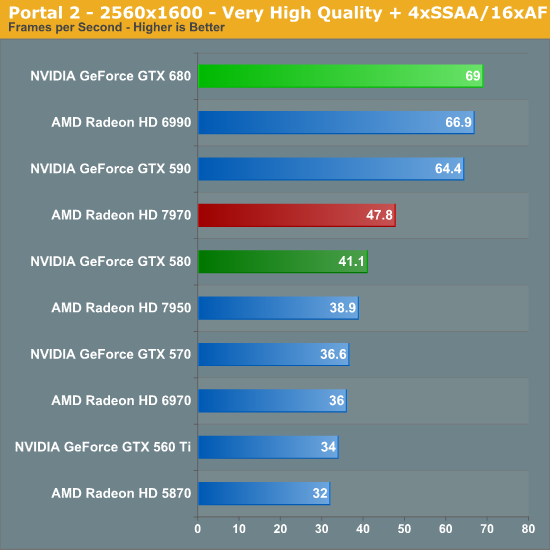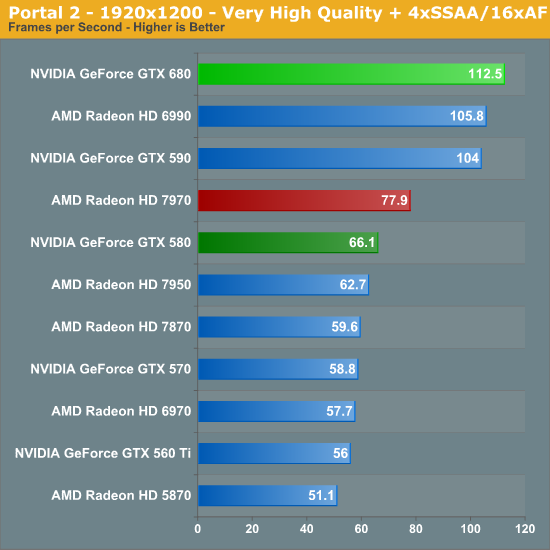NVIDIA GeForce GTX 680 Review: Retaking The Performance Crown
by Ryan Smith on March 22, 2012 9:00 AM ESTPortal 2
Portal 2 continues the long and proud tradition of Valve’s in-house Source engine. While Source continues to be a DX9 engine, Valve has continued to upgrade it over the years to improve its quality, and combined with their choice of style you’d have a hard time telling it’s over 7 years old at this point. Consequently Portal 2’s performance does get rather high on high-end cards, but we have ways of fixing that…




Portal 2 ends up being the strongest lead yet for the GTX 680, with the GTX 680 taking a 17% lead at 2560. What’s especially interesting though is performance in the bonus round with SSAA enabled – the GTX 680 takes a wholly unexpected and completely stunning 44% lead over the 7970. In fact it beats out everything here, including the GTX 590 and Radeon HD 6990. Meanwhile the lead over the GTX 580 is even more amazing, with the GTX 680 leading by 67% at these settings.
As it stands the GTX 680 is the first single-GPU card to do better than 60fps, and it does so in a landslide. All things considered, for a lack of memory bandwidth and ROP changes compared to Fermi GTX 680 does extremely well here.










404 Comments
View All Comments
george1976 - Saturday, March 24, 2012 - link
Excuse me sir but I think you've been reading the wrong article.Ryan Smith - Thursday, March 22, 2012 - link
Just a heads up guys, we're a bit behind schedule and are still adding images and tables, so hold on.casteve - Thursday, March 22, 2012 - link
whew - thought my coffee hadn't kicked in :)Granseth - Thursday, March 22, 2012 - link
Hi, liked the review but are missing a few things, though I expect them to be reviewed at a later time in a new article. Like the improved multi-screen support, SLI, overclocking and things like that.But I would like to know more about this turbo as well. What I am courious about is if it will boost minimum framerate as well as average framerate, or if the GPU is so taxed when it hits minimum framerate that it won't have anything extra to offer up to its turbo.
Ryan Smith - Thursday, March 22, 2012 - link
Minimum framerates. -16% power target on the left, stock on the right.Crysis Min: 21.4...21.9
Dirt3 Min: 73.4....77.1
So to answer your question, it depends on the game.
Jamahl - Thursday, March 22, 2012 - link
Just a comment on the power draw - I wonder if you could test the 680 and 7970 in a different game, say for example Batman of BF3. The reason for this is due to the 7970 winning in Metro, while losing in most of the others and I wonder if there is something going on regarding power draw.CeriseCogburn - Friday, March 23, 2012 - link
See the GTX 680 win in Metro 2033 all the way on up 1920 and 2560 resolutions >http://hothardware.com/Reviews/NVIDIA-GeForce-GTX-...
What's different is AAA is used, as well as the Sandy E runs stock at 3,300 and is not overclocked.
What appears to be a big problem for AMD cards is they have been offloading work to the cpu much more than the Nvidia cards, and even more so in CF v SLI, so when you don't have a monster CPU with a monster overclock to boot the AMD cards lose even worse.
SlyNine - Friday, March 23, 2012 - link
Anandtech uses AAA for Metro.You need to look agian, the difference is no DOF and hothardware is running at lower settings.
you, fail.
CeriseCogburn - Tuesday, March 27, 2012 - link
Oh I didn't fail, I showed the 680 winning in the game that is claimed it loses in.That's a WIN for me, period.
SlyNine - Friday, April 27, 2012 - link
Ok so your 500$ video card can win at lower settings than the 459$ videocard.